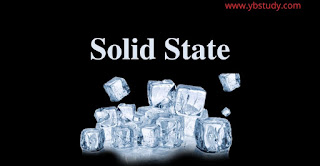How are Crystalline Solids Classified?
The crystalline solids have definite characteristic shapes.They have regular arrangement of the constituent particles They are said to exhibit long range order particles.
They have sharp and characteristic melting point. When cleave a sharp edged tool break into 2 pieces and the newly generated surface are plain and smooth.
They have fix and characteristic enthalpy of fusion. They are not isotropic . They are true solids Copper, silver, iron, common salt, zinc sulphide potassium nitrate, etc.
On the basis of intermolecular forces operating in them, crystalline solids are classified into four types:
How are Crystalline Solids Classified?
1) Molecular solids.
2) Ionic solids.
3) Metallic solids.
4) Covalent solids.
1) Molecular solids :
- crystalline solids in which constituent particles are molecules are called molecular solids.
- Molecular solids are subdivided into three types as
a) polar molecular solids
- Constituent particles are polar covalent molecules.
- Polar molecules possess permanent dipole moment.
- Molecules are hold together by strong dipole – dipole interaction.
- They are soft and bad conductor of electricity.
- In solid polar molecular arrange themselves in such a way that opposite charges of neighbouring molecules are close to each other.
- Their melting points are low due to weak bonding.
- Example : solid HCl, SO2
b) Non-polar molecular solids:
- Constituent particles are non polar covalent molecules, weakly polar molecules or atoms like He and Ar.
- Molecules are hold together by weak dispersion forces.
- They are smooth and bad conductor of electricity.
- Melting points are very low.
- Ex. CO2, H2, Cl2, CO.
C) Hydrogen bonded Molecular Solids:
Hydrogen bond : If hydrogen atom in a molecule is bonded covalently to strong electronegative atom like oxygen, nitrogen or fluorine then H-atom acquires additional positive charge and shows ability to form additional bond called Hydrogen bond with strong electronegative atom in the vicinity.
- Molecules are hold together by hydrogen bonds.
- They are soft and bad conductor of electricity
- Their melting points are low.
Hydrogen bonding in ice and water:
- In H2O each H atom forms additional bond with atom of another molecule.
- In water molecule are joined together by H-bond.
- Volume of 1 mole water = 18 cm.
- Actual volume occupied by H2O molecules is 9 Cm3.
- Hence nearly half of space is empty.
- Due to this density of ice is low.
- when ice melts some H- bonds break down.
2) Ionic Solids :
The solids in which constituent particles are (+) vely and (-) vely charged particles are known as ionic solids. Ions are hold together by strong electrostatic force of attraction.Arrangement of ions depends on
- a) Sizes ot cation and anion
- b) Charges on the ions
- c) The ease with which the anion can be polarised.
- They are hard and brittle.
- They possess higher melting point
- They are non conductors of electricity, but in fused state or in aqueous solution they can conduct electricity due to presence of free ions.
- On applying cutting force ionic crystal undergo distortion and fracture.
3) Metallic solids :
- Positive ions of the metal and delocalised are the constituent particles.
- The force of attraction between positively charged metallic ion and negatively charged seq of delocalised is called metallic bond.
- Good conductor of heat and electricity
- On applying shearing forces , the layer side on one another and structure is not fractured .
- Metallic bonds are stronger than 10nic and covalent bonds.
- They are malleable and ductile they exhibit lustre of grey or silvery. Gold -Yellow lustre Copper- red lustre
- Ex. Cu, Ag, Au.
4) Covalent solids:
- Solids in which constituent particles are atoms of non metallic solids
- They are also called giant solids.
- Atoms are held by strong covalent bond.
- They may be hard or brittle
- They are either good conductor of electricity or act as insulators.
- They have extremely high melting point and may decompose before melting
- Ex: Diamond, graphite and fullerene. Silicon, carbide.
1) Diamond :
- It is ari allotropic form of carbon
- All C-atoms are sp3 hybridised
- Strong covalent bonds are present in sp3 C- atoms
- It is very strong and hardest material
- It’s m.p . is 3930°C
- In diamond C-C bond length is 154 pm
- Uses: In jewellery
2) Graphite:
- It is also allotropic form of Carbon
- All carbon atoms are sp3 hybridised
- Each carbon atom is covalently bonded to three neighbouring atoms in the same layers. 2Pz unhybridised orbital is involved in bonding.
- Layers are joined together by weak van der waal’s forces of attraction.
- ln graphite C – C bond length 141.5 pm and distance between two adjacent layer of C-atom is 340 pm.
- good conductor of electricity
- Uses: In Lubricants, in lead pencils, in Ribbons used for Printing in Computors and Type writers.

